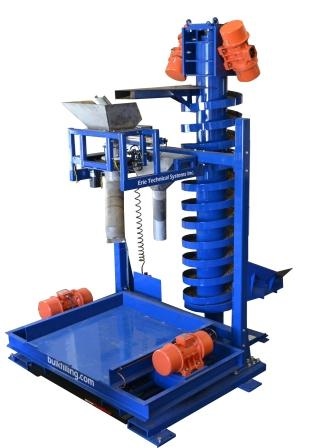Custom Material Handling System Maximizes Flexibility
November 4, 2016

A leading recycler of nickel-based alloys located in the eastern U.S. contacted Erie Technical Systems Inc. with a requirement to fill multiple drums on a skid, while automatically maximizing the fill weight for each of the containers. The customer contacted Erie Technical Systems because of a series of previous successful equipment installations handling their difficult material.
The first step was defining the project goals and challenges. From there, a custom material handling solution was developed, manufactured, and fully tested prior to shipment to the end user.
Project Goals
1. Maximize the amount of material in each drum independent of material density
2. Capture individual container weights as well as total gross, net, and tare weight
3. Accurately transfer weight data to the operator HMI and supervisory control system for quality control use
4. Fill all drums evenly to a common target weight
5. Take material samples throughout the process
6. Design the system to be capable of filling other containers on the same machine
7. Design the HMI and control system user friendly and simple
8. Minimize the footprint of the equipment as space is at a premium
Challenges
1. Varying material characteristics made it challenging to determine and optimize the densification and flow parameters.
2. Automatically determine how much material would fit into the drum without operator intervention
3. Material densities varied significantly so maximum weights would vary significantly
4. Limited space available for equipment
5. Equipment cleaning needed to be simple and quick for product change over.
6. Vertical conveying of material being introduced to the filling station was required.
7. Simplify the operator interface and control system
In order to satisfy the requirements of the project, the system components included: a vibratory spiral elevator; a customized filling and product distribution station; a vibratory densification table; load cell system; a laser level sensor; a custom-made sampling system; and an integrated control system.
The vibratory spiral elevator was able to perform the task of vertically conveying the material. It moved the material from the discharge of the crusher vertically 10 feet to the inlet of the drum filling machine. The use of the spiral elevator was the key to making this a viable project. Using the spiral elevator also provided another solution to the cleaning challenge, as it is inherently simple and quick to clean. Since there are no moving parts in the conveying path, the cleaning was done by simply wiping down the inside of the spirals. Furthermore, since the vibratory spiral elevator has few moving parts it presented a low-maintenance solution which was a major benefit.
Determining the maximum amount of material that could be packed in a drum required the use of two devices: a device to measure the material depth in the drum and a weighing device to help quantify the measurement. A laser was used as the measuring device for the product depth. The laser sent feedback to the PLC, which calculated the material depth in the drum. Weight was monitored and used to initiate the densification cycle. After initiating the densification cycle(s) the level of the material was monitored until it reached a pre-determined target level. Upon reaching this level the flow of material to the drum was stopped. Stopping the material flow was done by a PLC signal that closed the integral product valve built into the system below the surge hopper. Upon completion of filling of the first drum the weight in the drum was recorded and transferred to the PLC via Ethernet. This value then became the “target” weight for the rest of the drums on the skid. The information was also visible on the operators HMI. During the period of time the flow of material was paused the filling head rotated into position over the next drum. Assuming the surge hopper never signaled a high level condition no upstream processes were stopped or paused. If the surge hopper did reach the high level condition a signal would be sent to the upstream equipment requiring it to pause. The filling of the rest of the drums on the skid would continue until all drums were full.
In order to maximize the weight of product packaged in each drum a vibratory densification table was integrated into the system. The vibratory densification system enables the system to package more material into a container than would fit without any dynamic forces. The success of the densification table is two-fold: 1. It generates a force that flattens the materials natural angle of repose leaving more free board space in the drum which material can occupy; 2. Materials that are not homogenous in shape are dynamically moved until an interlocking of the particles takes place, which fills voids in the package and maximizes the packed density of the product.
To successfully take advantage of these opportunities testing must be done to determine the optimum frequency, G-Level, and stroke required to maximize the densification of the products being filled. The combination of these two things results in placing the most material possible in each drum. The benefit of this is reduced packaging and shipping costs.
The system weighing was done using a four load cell system with an Ethernet enable smart weigh indicator. The components were selected and modified to work on a vibrating densification style system. By combining the proper components, the system was able to weigh, fill, and densify simultaneously.
A sampling system was integrated into the machine to automatically sample material based on pre-programmed time intervals. The system also gave the operator control to take random samples as necessary. The custom-designed sampling system collected a sample and deposited the sample into the container of choice.
To integrate all of these components together a custom control system was designed. This system had to be user friendly and house the control capabilities to operate the system without interruption or appreciable down time. In order to do this a PLC and touch screen HMI were used. The scale and other components were connected to the PLC via Ethernet. This configuration reduced the amount of field wiring and gave flexibility to modify the operation as necessary. The main operator interface was a color touch screen HMI that provided an easy way to interact with the system, while giving a visual accounting of what the machine was doing at any time during the operational sequence. It also had to be configured to transfer data to a supervisory control system while having enough flexibility to easily manipulate what data is sent to the supervisory system in the future.
This system was designed to fill drums primarily. However, it is also capable and fitted with the necessary control recipes, automatic functionality, and operator input to fill multiple containers on the same machine. It is capable of filling boxes, totes, and different configurations of drums. The level of automation integrated into the system gave the end user the ultimate flexibility to add containers to the process without time consuming software or hardware changes.
As designed, the system has maximized the flexibility of the filling station and minimized the quantity of containers needed for specific batch sizes, all while reducing the footprint to the minimum space required for this type of equipment. The system can be made to accommodate many different product types and food grade units are also available.
For more information, contact Rick Sienerth, Erie Technical Systems Inc., at 814-899-2103, or visit www.bulkfilling.com.
You May Also Like

